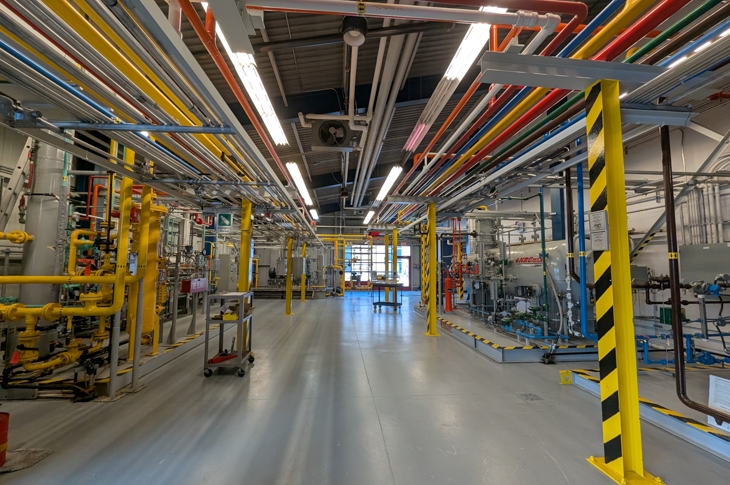5 careers in energy you never knew existed

Students at SAIT’s MacPhail School of Energy are learning skills to empower the energy sector — now and into the future.
The world of energy — traditional oil and gas, renewables, upstream, downstream, electric and more — is big. To fuel our routines (get it?), there are a thousand players in the complex energy ecosystem.
At SAIT’s MacPhail School of Energy, students are learning everything needed to maintain and improve the industries that power our province, while also moving us towards a sustainable future.
We went into Career Coach, SAIT’s tool for identifying viable career options based on skills, and pulled out five unique careers the MacPhail School of Energy can prepare you for — and we’re hoping to surprise you with some jobs you might not have known existed.
Driller and/or blaster
Picture this: The earth beneath your feet shakes a little but this little explosion wouldn’t scare you. You set this dynamite off. After studying it extensively, you know this quarry like the back of your hand — and exactly what force is required to safely dislodge the rock that’s in the way.
To understand the energy industry, you need to get to its core. To bring crude oil and raw natural gas to the surface, we first need to find energy reserves, then drill exploratory wells and continue to operate them in a safe way.
Makes sense, right? But who’s responsible for this?
Experts in drilling and blasting.
By understanding directional drilling, industry-standard equipment and the environment, people in this line of work examine blast areas to ensure safety laws are followed, manage explosives on worksites and use their prowess to loosen, remove and displace rocks and structures, usually for surface mining or construction.
Career path: Petroleum Engineering Technology
Equipment maintenance guru
Picture this: You’re in a commercial bakery, but there’s no heat rising from freshly baked bread. No freshly baked bread at all. That’s right. The oven is broken. The carbs are ruined.
There’s only one person who can save it, and it’s you.
Appliance service technicians and commercial appliance technicians are oft-unsung heroes of the services we see and use every day. These experts of installation, service and repair apply their skills to hospitality spaces, medical facilities, remote camps and transportation hubs. They also work with goods and service providers such as airports, railways, grocery stores and bakeries.
Career path: Appliance Service Technician
Biological technician
Picture this: You’re knee-deep in a wetland, as comfortable clambering around in waders and boots as you are in shorts and sneakers. You’re grabbing water samples right now, but next, you’ll be sitting on the rocks along the shore, using your tablet to record and interpret your findings. Are the environmental regulations being followed? Are the water and land in good ecological health? It’s your job to find out.
Biological technologists enter the field from many diverse backgrounds — environmental science, biotechnology, chemical engineering and other related disciplines. This field of work emphasizes technical precision, data analysis, environmental compliance and laboratory and field techniques. Professionals in this field contribute meaningfully to sustainability and conservation in both public and private sector initiatives.
Career path: Integrated Water Management
Career path: Environmental Technology
Get a frog’s eye view
If you have an interest in how environmental protection, oil and gas regulations and wildlife intersect, check out our story about land reclamation, the amazing frogs who watched it happen — and where SAIT comes in.
See how we're celebrating reclamationMechatronics technician
Picture this: It’s like assembling the robot you had as a kid — except this time, it runs real machines. There’s a diagram in front of you. You’ve been tracing your finger along the components of a pneumatic system. Because you went to SAIT, you know what a pneumatic system is. You need to keep these components separate from the electrical parts, but all of it, ultimately, needs to connect to microcomputer devices, enabling you to control the device remotely.
The relationship between these fine and finicky systems is the heart of mechatronics engineering technology. Combining electrical, mechanical and pneumatic (air and gas related) pieces improves technology use and empowers automated systems.
The kinds of systems vary. Sometimes, they control the flow of air, water and electricity through commercial devices. Sometimes, they affect sensors. Sometimes, they really are for robots, used in fields from development to healthcare.
Career path: Instrumentation and Control Technician
Stakeholder engagement specialist
Picture this: A little house sits beneath blue skies, surrounded by far-reaching fields of tall grass and potato flowers. You’re here to understand the landowner’s concerns and priorities for their land and help put their mind at ease about a proposed wind farm in their region.
This is a reality of many engagement experts, land administrators and community relations representatives — though sometimes the work is done from an air-conditioned office rather than under the summer sun, or the project is about a bustling urban area rather than a quiet rural one. In this line of work, people bridge the gap between companies, governments, regulatory bodies and landowners. It’s a chance to work with people directly while also demonstrating your expertise about impact, zoning, land use and development. It requires a jack-of-all-trades mindset and willingness to learn about many things, depending on industry: environmental science, oil and gas, biology, engineering and construction.
Career path: Land Analyst

See inside SAIT’s coolest energy labs
SAIT is all about demystifying industry — it’s why many of our labs are designed and equipped like real workplaces!


Oki, Âba wathtech, Danit'ada, Tawnshi, Hello.
SAIT is located on the traditional territories of the Niitsitapi (Blackfoot) and the people of Treaty 7 which includes the Siksika, the Piikani, the Kainai, the Tsuut’ina and the Îyârhe Nakoda of Bearspaw, Chiniki and Goodstoney.
We are situated in an area the Blackfoot tribes traditionally called Moh’kinsstis, where the Bow River meets the Elbow River. We now call it the city of Calgary, which is also home to the Métis Nation of Alberta.